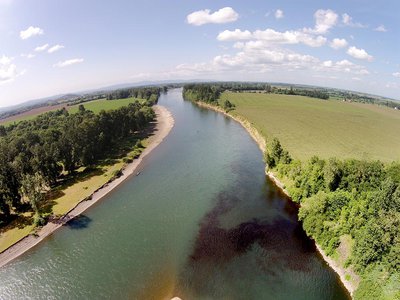
It’s rafting season on Oregon’s rivers, and the last thing water enthusiasts want to see is a dark smear of effluent in the river as they drift by. Travis Williams saw just that — a dark patch of pollutants in the Willamette River — as he paddled past the outflow for Cascade Pacific Pulp in Halsey, south of Corvallis, in May.
Williams is the executive director of Willamette Riverkeeper, and this is not the first time he has dealt with a murky patch on this particular outflow on the river. The area is a “mixing zone” where Cascade Pacific discharges chemicals including arsenic, pentachlorophenol, mercury and free cyanide, according to its permit with the Department of Environmental Quality.
The U.S. Environmental Protection Agency says a mixing zone “is an allocated impact zone where water quality criteria can be exceeded as long as acutely toxic conditions are prevented.” In other words, it’s a legal area to pollute. The expectation is that the water will swiftly dilute the zone and, under the law, water quality criteria must be met at the edges of the zone.
Willamette Riverkeeper threatened to sue Cascade Pacific over its effluent in 2012, and in April of 2013 a settlement was reached in which Cascade Pacific agreed to dredge to improve water flows by the outfall. The company also gave Eugene-based McKenzie River Trust $10,000 toward its Green Island restoration project at the confluence of the McKenzie and the Willamette as part of the settlement.
Pat Rank, the pulp mill’s general manager, says the geomorphologists consulted by Cascade Pacific said the channel the company dredged would be “viable for 10 years” with only minor maintenance. Rank says work will begin this week to restore the flows and that Cascade Pacific is “not real happy” major maintenance is required only a year after doing the work. He attributes higher river flows to the gravel buildup that caused the effluent to reappear.
The effluent is 9 miles from the city of Corvallis’ water intake. Williams says while he appreciates the work Cascade Pacific is doing, when it comes to the outflow from the pulp mill, “I don’t want it there at all. I don’t think that size of discharge is good for that stretch of the river.” He says another option would be to relocate the diffuser that releases the discharge downstream and to deeper water.
Williams says, “I get it” that the mill is necessary — it makes pulp for tissue and toilet paper — but “what’s the cost of that?”
Rank says Cascade Pacific is also “evaluating other alternatives” for a long-term fix to the problem.